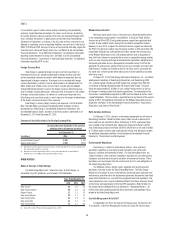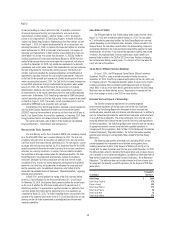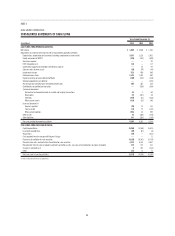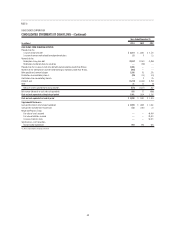Duke Energy 2014 Annual Report Download - page 79
Download and view the complete annual report
Please find page 79 of the 2014 Duke Energy annual report below. You can navigate through the pages in the report by either clicking on the pages listed below, or by using the keyword search tool below to find specific information within the annual report.
59
PART II
to oversee handling of coal ash within the state; (ii) prohibits construction
of new and expansion of existing ash impoundments and use of existing
impoundments at retired facilities, effective October 1, 2014; (iii) requires
closure of ash impoundments at Duke Energy Progress’ Asheville and Sutton
stations and Duke Energy Carolinas’ Riverbend and Dan River stations no later
than August 1, 2019; (iv) requires dry disposal of fl y ash at active plants not
retired by December 31, 2018; (v) requires dry disposal of bottom ash at active
plants by December 31, 2019, or retirement of active plants; (vi) requires all
remaining ash impoundments in North Carolina to be categorized as high-risk,
intermediate-risk, or low-risk no later than December 31, 2015 by The North
Carolina Department of Environment and Natural Resources (DENR) with the
method of closure and timing to be based upon the assigned risk, with closure
no later than December 31, 2029; (vii) establishes requirements to deal with
groundwater and surface water impacts from impoundments and (viii) enhances
the level of regulation for structural fi lls utilizing coal ash. The Coal Ash Act
includes a variance procedure for compliance deadlines and modifi cation of
requirements regarding structural fi lls and compliance boundaries. Provisions
of the Coal Ash Act prohibit cost recovery for unlawful discharge of ash basin
waters occurring after January 1, 2014. The Coal Ash Act included a moratorium
for any NCUC ordered rate changes to effectuate the legislation, which ended
January 15, 2015. The Coal Ash Act leaves the decision on cost recovery
determinations related to closure of CCR surface impoundments (ash basins
or impoundments) to the normal ratemaking processes before utility regulatory
commissions. In November 2014, Duke Energy submitted to DENR site specifi c
coal ash excavation plans for the four high priority stations required to be closed
no later than August 1, 2019. These plans and all associated permits must be
approved by DENR before any excavation work can begin.
In September 2014, Duke Energy Carolinas executed a consent agreement
with the South Carolina Department of Health and Environmental Control
(SCDHEC) requiring the excavation of an inactive ash basin and ash fi ll area at
the W.S. Lee Steam Station. As part of this agreement, in December 2014, Duke
Energy Carolinas fi led an ash removal plan and schedule with SCDHEC.
For further information, refer to Note 5 of the Condensed Consolidated
Financial Statements, “Commitments and Contingencies.”
Mercury and Air Toxics Standards
The fi nal Mercury and Air Toxics Standards (MATS) rule, previously referred
to as the Utility MACT Rule, was issued on February 16, 2012. The fi nal rule
establishes emission limits for hazardous air pollutants from new and existing
coal-fi red and oil-fi red steam electric generating units. The rule requires sources
to comply with emission limits by April 16, 2015. Under the Clean Air Act (CAA),
permitting authorities have the discretion to grant up to a one-year compliance
extension, on a case-by-case basis, to sources that are unable to complete
the installation of emission controls before the compliance deadline. The Duke
Energy Registrants have requested and received a number of compliance
extensions. Strategies to achieve compliance with the fi nal rule will include
installation of new air emission control equipment, development of monitoring
processes, fuel switching, and acceleration of retirement for some coal-fi red
electric-generation units. For additional information, refer to Note 4 to the
Condensed Consolidated Financial Statements, “Regulatory Matters,” regarding
potential plant retirements.
In April 2014, several petitions for review of the fi nal rule were denied
by the U.S. Court of Appeals for the District of Columbia (D.C. Circuit Court).
On November 25, 2014, the Supreme Court granted a petition for review based
on the issue of whether the EPA unreasonably refused to consider costs in
determining whether it is appropriate to regulate hazardous air pollutants from
coal-fi red and oil-fi red steam electric generating units. Oral arguments are
scheduled for March 25, 2015. The Duke Energy Registrants cannot predict the
outcome of the Supreme Court review of the D.C. Circuit Court decision and are
planning for the rule to be implemented as promulgated given the imminent
compliance deadline.
Clean Water Act 316(b)
The EPA published the fi nal 316(b) cooling water intake structure rule on
August 15, 2014, with an effective date of October 14, 2014. The rule applies
to 27 of the electric generating facilities the Duke Energy Registrants own and
operate depending on unit retirement dates, excluding stations included in the
Disposal Group. The rule allows several options for demonstrating compliance
and provides fl exibility to the state environmental permitting agencies to make
determinations on controls, if any, that will be required for cooling water intake
structures. Any required intake structure modifi cations and/or retrofi ts are
expected to be installed in the 2019 to 2022 time frame. Petitions challenging
the rule have been fi led by several groups. It is unknown at this time when the
courts will rule on the petitions.
Steam Electric Effl uent Limitation Guidelines
On June 7, 2013, the EPA proposed Steam Electric Effl uent Limitations
Guidelines. The EPA is under a revised court order to fi nalize the rule by
September 30, 2015. The EPA has proposed eight options for the rule, which vary
in stringency and cost. The proposed regulation applies to seven waste streams,
including wastewater from air pollution control equipment and ash transport
water. Most, if not all, of the steam electric generating facilities the Duke Energy
Registrants own are likely affected sources. Requirements to comply with the
fi nal rule may begin as early as late 2018 for some facilities.
Estimated Cost and Impacts of Rulemakings
The ultimate compliance requirements for currently proposed
environmental regulations will not be known until all the rules have been
fi nalized. The Duke Energy Registrants also expect to incur increased fuel,
purchased power, operation and maintenance, and other expenses, in addition to
costs for replacement generation for potential coal-fi red power plant retirements
as a result of these regulations. The actual compliance costs incurred may be
materially different from these estimates based on the timing and requirements
of the fi nal regulations. The Duke Energy Registrants intend to seek rate recovery
of appropriate amounts incurred associated with regulated operations in
complying with these regulations. Refer to Note 4 to the Condensed Consolidated
Financial Statements, “Regulatory Matters,” for further information regarding
potential plant retirements and regulatory fi lings related to the Duke Energy
Registrants.
The following table provides estimated costs, excluding AFUDC, of new
control equipment that may need to be installed on existing power plants,
including conversion of plants to dry disposal of bottom ash and fl y ash, to
comply with the above regulations over the fi ve years ended December 31, 2019.
The table excludes amounts related to the Disposal Group and ash basin closure
costs recorded as asset retirement obligations, for additional information refer to
Note 9 of the Condensed Consolidated Financial Statements, “Asset Retirement
Obligations.” The table also does not include estimated ash basin closure costs
to comply with the recently issued EPA regulations for the disposal of CCR from
power plants.
(in millions)
Estimated 5
Year Cost
Duke Energy $ 1,850
Duke Energy Carolinas 675
Progress Energy 525
Duke Energy Progress 475
Duke Energy Florida 50
Duke Energy Ohio 75
Duke Energy Indiana 575
























